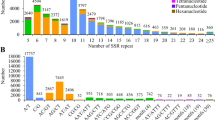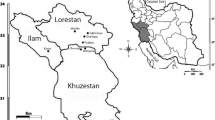Abstract
Aspidopterys obcordata var. obcordata, a medicinal plant endemic to China, is a narrowly distributed species and wild resources are extremely limited. To evaluate the genetic variability and degree of genetic divergence of A. obcordata var. obcordata, and to make rational scientific decisions on its harvest and germplasm conservation, we collected 122 samples from across nearly all of its distribution area and studied genetic diversity using inter-simple sequence repeats (ISSRs), sequence-related amplified polymorphisms (SRAPs), and a method combining the two techniques. The results revealed the high genetic diversity of A. obcordata var. obcordata, mainly due to its intra-population diversity, and the top two populations with the highest levels of intra-population diversity were ML and DH, individuals of which can serve as excellent germplasm candidates during the processing of germplasm screening and conservation. In general, the combining method was prior to the ISSR analyses and SRAP analyses results, except for a slight difference in the genetic structure of individual populations. Therefore, we suggest that a combination analysis of the two marker methods is ideal for evaluating the genetic diversity and genetic relationships of A. obcordata var. obcordata.




Similar content being viewed by others
Abbreviations
- ISSR:
-
Inter-simple sequence repeat
- SRAPs:
-
Sequence-related amplified polymorphisms
- UPGMA:
-
Unweighted pair group method with arithmetic means
- AMOVA:
-
Analyses of molecular variance
- PCA:
-
Principal component analyses
References
Bracci T, Busconi M, Fogher C, Sebastiani L (2011) Molecular studies in olive (Olea europaea L.): overview on DNA markers applications and recent advances in genome analysis. Plant Cell Rep. 30:449–462
Culley TM, Wolfe AD (2001) Population genetic structure of the cleistogamous plant species Viola pubescens Aiton (Violaceae), as indicated by allozyme and ISSR molecular markers. Heredity 86:545–556
Das A, Kesari V, Satyanarayana VM, Parida A, Rangan L (2011) Genetic relationship of Curcuma Species from Northeast India using PCR-based markers. Mol Biotechnol 49:65–76
Food and drug administration of Yunnan province (2005) The standard of traditional Chinese medicine of Yunnan Province-Dai medicine. Yunnan science and Technology Press, Yunnan
Frascaroli E, Schrag TA, Melchinger AE (2013) Genetic diversity analysis of elite European maize (Zea mays L.)inbred lines using AFLP, SSR, and SNP markers reveals ascertainment bias for a subset of SNPs. Theor Appl Genet 126:133–141
Guowen X, Xiaoyu P, Yanling Z, Jinxing Z (2007) Genetic diversity of endangered plant Monimopetalum Chinense in China detected by ISSR analysis. Scientia silvae sinicae 43(8):48–52
Kaya HB, Cetin O, Kaya H, Sahin M, Sefer F, Kahraman A, Tanyolac B (2013) SNP discovery by Illumina-based transcriptome sequencing of the olive and the genetic characterization of Turkish olive genotypes revealed by AFLP SSR and SNP markers. PLoS ONE 8:e73674
Li H-T, Peng C-Z, Guan Y-H, Niu Y-F, Zhang L-X (2011) Investigation on the resources of A. obcordata var. obcordata. Lishizhen medicine and materia medica research. 22(12):2999
Li-xia Z, Chao-zhong P, Ying-feng N, Hai-tao L (2011) Study on cutting propagation of Dai medicine Aspidopterys obcordata var. obcordata. Chin Agric Sci Bull 27(19):125–128
Li-xia Z, Ying-feng N, Hai-tao L, Chao-zhong P, Yan-hong G (2012) Preliminary study on seed germination characteristics of Dai medicine Aspidopterys obcordata var. obcordata. Seed 31(1):28–30
Lü YD, Zhao L, Xu XY, Wang L, Wang C, Zhang TZ, Guo WZ (2013) Characterization of expressed sequence tags from developing fibers of Gossypium barbadense and evaluation of insertion deletion variation in tetraploid cultivated cotton species. BMC Genomics 14:170
Mantel N (1967) The detection of disease clustering and generalized regression approach. Cancer Res 27:209–220
Mardis ER (2008a) Next-generation DNA sequencing methods. Annu Rev Genomics Hum Genet 9:387–402
Mardis ER (2008b) The impact of next-generation sequencing technology on genetics. Trends Genet 24:133–141
Morozova O, Marra MA (2008) Applications of next-generation sequencing technologies in functional genomics. Genomics 92:255–264
Nei M (1973) Analysis of gene diversity in subdivided populations. Proc Natl Acad Sci USA 70:3321–3323
Peakall R, Smouse PE (2006) GenAIEx 6: genetic analysis in excel. Population genetic software for teaching and research. Mol Ecol Notes 6:288–295
Rohlf FJ (2000) NTSYS-pc numerical taxonomy and multivariate analysis system. Version 2. 1. Exeter Software, Setauket, New York
Saidi M, Movahedi K, Mehrabi AA, Kahrizi D (2013) Molecular genetic diversity of Satureja bachtiarica. Mol Biol Rep. 40:6501–6508
Schaal BA, Leverich WJ, Rogstad SH (1991) Comparison of methods for assessing genetic variation in plant conservation biology. In: Falk DA, Holsinger KE (eds) Genetics and conservation of rare plants. Oxford University Press, New York, pp 123–134
Shendure J, Ji H (2008) Next-generation DNA sequencing. Nat Biotechnol 26:1135–1145
Song M-F, Li Y-H, Zhang Z-L, Lv Y-N, Li X-L, Guang L (2015a) Inhibiting effect of A. obcordata var. obcordata on renal calculus. Chin J New Drugs 24(9):1047–1051
Song M-F, Guang L, Chen X, Zhang Z-L, Lv Y-N, Li X-L, Li Y-H (2015b) Inhibitory effects of A. obcordata var. obcordata extract on renal calcium oxalate stone formation in rats. China Pharm 26(10):1329–1332
Song M-F, Li Y-H, Li X-L, Zhang Z-L, Lv Y-n, Guang L (2016) Preventive effects of A. obcordata var. obcordata on renal tubular epithelial cells injury. Med Guide 35(3):249–252
Su Z, Ning B, Fang H, Hong H, Perkins R, Tong W, Shi L (2011) Next-generation sequencing and its applications in molecular diagnostics. Expert Rev Mol Diagn 11:333–343
Sulima P, Prinz K, Przyborowski JA (2017) Genetic diversity and genetic relationships of Purple Willow (Salix purpurea L.) from Natural Locations. Int J Mol Sci. 19(1):105
Sulima P, Prinz K, Przyborowski JA (2018) Genetic diversity and genetic relationships of Purple Willow (Salix purpurea L.) from natural locations. Int J Mol Sci 19(1):105
Tan Z-G (2010) One cases of cholecystolithiasis treated by A. obcordata var. obcordata. Chin J Nat Med 10:42–43
Varshney RK, Nayak SN, May GD, Jackson SA (2009) Next-generation sequencing technologies and their implications for crop genetics and breeding. Trends Biotechnol 27:522–530
Wang H, Jiang J, Chen S, Qi X, Peng H, Li P, Song A, Guan Z, Fang W, Liao Y, Chen F (2013) Next-generation sequencing of the Chrysanthemum nankingense (Asteraceae) transcriptome permits large-scale unigene assembly and SSR marker discovery. PLoS ONE 8(4):e62293
Xiao-hua Li, Ying-feng N, Chao Y, Li-xia Z (2014) The chemical constituents of Aspidopterys Obcordata Hemsl by comprehensive preliminary test. Guiding J Trad Chin Med Pharma 20(5):17–21
Yeh FC, Yang R, Boyle TJ, Ye Z, Xiyan JM (2000) POPGENE 32, Microsoft windows-based freeware for population genetic analysis. Molecular biology and biotechnology center University of Alberta, Edmonton
Yongli C, Jia G (2000) Progress and problem of vine adaptive ecology. Chin J Ecol 19(6):28–33
Yu L-D, Hu J-B (2009) Combination of A. obcordata var obcordata and five drenched fossils capsule in the treatment of renal calculi. Chin J Nat Med 10:25
Yu JN, Won C, Jun J, Lim Y, Kwak M (2011) Fast and cost-effective mining of microsatellite markers using NGS technology: an example of a Korean water deer Hydropotes inermis argyropus. PLoS ONE 6(11):e26933
Zalapa JE, Cuevas H, Zhu H, Steffan S, Senalik D, Zeldin E, Mccown B, Harbut R, Simon P (2012) Using next-generation sequencing approaches to isolate simple sequence repeat (SSR) loci in the plant sciences. Am J Bot 99:193–208
Zhang Q-S, Bing-lian Xu, Liu L-d, Yuan Q-Q, Dong H-X, Cheng X-H, Lin D-L (2012) Analysis of genetic diversity among Chinese Pleurotus citrinopileatus singer cultivars using two molecular marker systems (ISSRs and SRAPs) and morphological traits. World J Microbiol Biotechnol 28:2237–2248
Zhan-lin L, Gui-fang Z (1999) Population genetics and its implications for conservation of rare and endangered plants. Chin Biodivers 7(4):340–346
Zheng-feng W, Shao-lin P (2003) Plant conservation genetics. Acta Ecol Sin 23(1):158–166
Zheng-feng W, Xue-jun Ge (2009) Not only genetic diversity: advances in plant conservation genetics. Biodivers Sci 17(4):330–339
Funding
This research was funded by CAMS Initiative for Innovative Medicine (Grant No. 2017-12M-B&R-09) and Special subsidies for public health service of TCM "the national survey of TCM resources" (Grant No. DSS, MOF. No 66/2017).
Author information
Authors and Affiliations
Contributions
L-XZ fund this study. Z-LZ designed the experiment, collected plant material, and analyzed experimental data. M-FS performed the experiment, analyzed experimental data, and drafted the manuscript. Y-HG and H-TL collected plant material. YZ provided experimental help. The authors are accountable for all aspects of the work.
Corresponding authors
Ethics declarations
Conflict of interest
The authors declare no conflict of interest.
Additional information
Publisher's Note
Springer Nature remains neutral with regard to jurisdictional claims in published maps and institutional affiliations.
Electronic supplementary material
Below is the link to the electronic supplementary material.
Rights and permissions
About this article
Cite this article
Song, MF., Guan, YH., Zhang, Y. et al. Genetic Diversity Assessment of a Chinese Medicinal Endemic Species, Aspidopterys obcordata var. obcordata, by Combined Molecular Marker Methods (ISSR & SRAP). Biochem Genet 59, 283–299 (2021). https://doi.org/10.1007/s10528-020-10001-2
Received:
Accepted:
Published:
Issue Date:
DOI: https://doi.org/10.1007/s10528-020-10001-2




